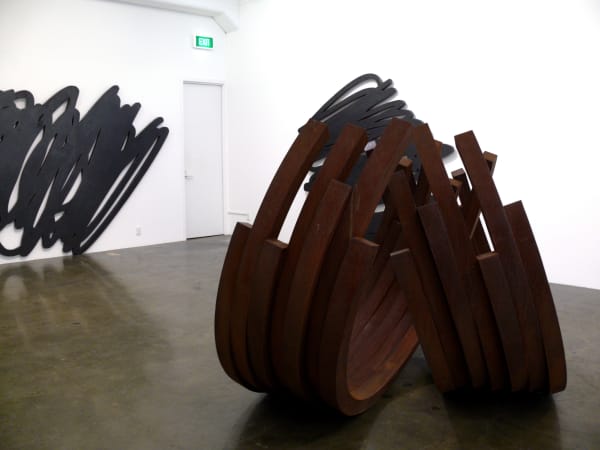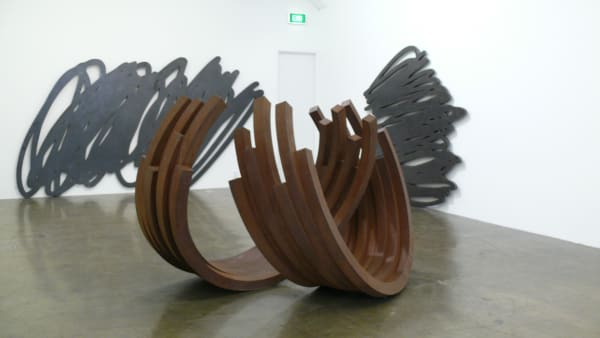Bernar Venet
Past exhibition
Overview
Throughout his career, Venet has made pioneering contributions to the discourse of sculptural practice and has emerged one of the most significant artists of his generation. Although he is best known for his large-scale steel sculptures with a Minimalist aesthetic, Venet’s oeuvre is more diverse than his distinctive steel works may suggest.
In Nice stands one of France’s tallest public artworks, 9 lignes obliques (2010). More than 30 meters tall, nine vertical steel beams penetrate the coastal city’s skyline. In Austin, Texas, the right angle of an office building is contrasted by the colossal angular red form of 19.5° Angle (1986). At a sculpture park in New York, the singular Cor-ten beam in Straight Line (2000) rises above the treeline and a steel arc appears to precariously balance on the headquarters of Dongkuk Steel Mill Co. in downtown Seoul, South Korea, in 37.5° Arc (2010). Last year, the Cor-ten form of 85.8° Arc x 16 (2011) flanked the entrance to the Château of Versailles and the Palace grounds housed a solo exhibition of six further sculptures. These works - along with several installations around the world, including Japan, Korea, Germany, Norway and now in New Zealand – demonstrate the prominence of French artist Bernar Venet.
Installation Views
Press release
In Nice stands one of France’s tallest public artworks, 9 lignes obliques (2010). More than 30 meters tall, nine vertical steel beams penetrate the coastal city’s skyline. In Austin, Texas, the right angle of an office building is contrasted by the colossal angular red form of 19.5° Angle (1986). At a sculpture park in New York, the singular Cor-ten beam in Straight Line (2000) rises above the treeline and a steel arc appears to precariously balance on the headquarters of Dongkuk Steel Mill Co. in downtown Seoul, South Korea, in 37.5° Arc (2010). Last year, the Cor-ten form of 85.8° Arc x 16 (2011) flanked the entrance to the Château of Versailles and the Palace grounds housed a solo exhibition of six further sculptures. These works - along with several installations around the world, including Japan, Korea, Germany, Norway and now in New Zealand – demonstrate the prominence of French artist Bernar Venet.
Throughout his career, Venet has made pioneering contributions to the discourse of sculptural practice and has emerged one of the most significant artists of his generation. Although he is best known for his large-scale steel sculptures with a Minimalist aesthetic, Venet’s oeuvre is more diverse than his distinctive steel works may suggest. As a young artist Venet was associated with the conceptual art movement, yet from the late 1960s he began to reject the notion of style, favouring works that transcended traditional artistic categories. Over time his works became particularly concerned with issues of monumentality and the relationship of contemporary works in pre-established contexts.
For Bernar Venet, Venet’s second solo exhibition with Gow Langsford Gallery, works from two serieswill be exhibited: his well-known Arcs and more recent GRIB works.
Generally speaking, Venet’s practice has been characterized by an enduring but evolutional engagement with mathematical precision and its contradictory counterpart, the uncertain. In early drawings, Venet incorporated mathematical formulae to represent rational logic and high aesthetics. These works explored the impersonal laws of physics and mathematics and in a sense, represent an attempt to liberate art from aesthetic rules.
His Arc series are eloquent examples of his works with overt mathematical associations. 218.5° Arc x 14 (2008) and 79.5° Arc x 8 (2010) both included in this exhibition, appear on the one hand fluid, as if based on penned gestures of the artist, but are grounded in a rigid stringency via their association to science and mathematics, which is confirmed by the works’ titles.
In contrast, Venet’s Indeterminate Lines series with their organic and seemingly gestural sculptural forms, seemingly oppose the calculable and rational logic of the early paintings and Arcs. The Indeterminate Lines themselves are challenging to define – moving around them their lines appear to contract and elongate, winding in, on and around themselves, thus deducing a finite solid form is difficult. They offer no obvious metaphorical reading and do not appear to refer to anything outside of themselves.
The GRIB works, five of which are shown here, can be understood to continue the dialogue between the mathematical and the gestural. Created from torch-cut steel, these wall-mounted works are like lively sketches, and an extension of the original wooden Indeterminate Lines that were displayed as reliefs between 1979 and 1983. The GRIB series confront the viewer with the fact of sheer matter - the spontaneity of the drawings countered by their monumental physicality.
Throughout his career, Venet has made pioneering contributions to the discourse of sculptural practice and has emerged one of the most significant artists of his generation. Although he is best known for his large-scale steel sculptures with a Minimalist aesthetic, Venet’s oeuvre is more diverse than his distinctive steel works may suggest. As a young artist Venet was associated with the conceptual art movement, yet from the late 1960s he began to reject the notion of style, favouring works that transcended traditional artistic categories. Over time his works became particularly concerned with issues of monumentality and the relationship of contemporary works in pre-established contexts.
For Bernar Venet, Venet’s second solo exhibition with Gow Langsford Gallery, works from two serieswill be exhibited: his well-known Arcs and more recent GRIB works.
Generally speaking, Venet’s practice has been characterized by an enduring but evolutional engagement with mathematical precision and its contradictory counterpart, the uncertain. In early drawings, Venet incorporated mathematical formulae to represent rational logic and high aesthetics. These works explored the impersonal laws of physics and mathematics and in a sense, represent an attempt to liberate art from aesthetic rules.
His Arc series are eloquent examples of his works with overt mathematical associations. 218.5° Arc x 14 (2008) and 79.5° Arc x 8 (2010) both included in this exhibition, appear on the one hand fluid, as if based on penned gestures of the artist, but are grounded in a rigid stringency via their association to science and mathematics, which is confirmed by the works’ titles.
In contrast, Venet’s Indeterminate Lines series with their organic and seemingly gestural sculptural forms, seemingly oppose the calculable and rational logic of the early paintings and Arcs. The Indeterminate Lines themselves are challenging to define – moving around them their lines appear to contract and elongate, winding in, on and around themselves, thus deducing a finite solid form is difficult. They offer no obvious metaphorical reading and do not appear to refer to anything outside of themselves.
The GRIB works, five of which are shown here, can be understood to continue the dialogue between the mathematical and the gestural. Created from torch-cut steel, these wall-mounted works are like lively sketches, and an extension of the original wooden Indeterminate Lines that were displayed as reliefs between 1979 and 1983. The GRIB series confront the viewer with the fact of sheer matter - the spontaneity of the drawings countered by their monumental physicality.
Enquire



















